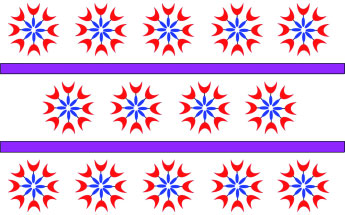| Posted: May 02, 2011 | |
Avoiding allergic drug reactions with a supramolecular string of pearls |
|
| (Nanowerk Spotlight) Heparin is widely used as an anti-coagulant to prevent the formation of blood clots. This naturally occurring biological molecule is commonly used during surgery for blood thinning. At the end of surgery, heparin has to be removed in order to allow the blood to clot again – this is currently done using a protein called protamine, the only clinically approved heparin binder. Unfortunately, protamine – a natural product extracted from shellfish – can cause severe allergic reactions in a number of patients. | |
| Researchers at the University of York in the UK have now developed a synthetic molecule which is capable of binding heparin just as effectively as protamine. The team's approach may eventually be useful for developing protamine replacements. | |
| "We designed small molecules that spontaneously self-assemble into nanosized spheres (micelles) which mimic the size, shape and surface charge of protamine and contain multiple heparin binding units," David Smith, a professor in the Department of Chemistry, tells Nanowerk. "We demonstrated that under simple conditions, our binder was at least as effective as protamine for heparin binding. Also, we could visualize the binding of our spherical self-assembled protamine mimic along the heparin polymer chains on the nanoscale using electron microscopy." | |
| Smith and his team reported their findings in the April 19, 2011 online edition of Angewandte Chemie International Edition ("Self-Assembling Ligands for Multivalent Nanoscale Heparin Binding"). | |
 |
|
| Polycationic ligands are designed to self-assemble into spherical pseudo-dendrimers that are capable of binding polyanionic heparin with affinities and binding modes similar to covalent nanostructures such as dendrimers and proteins (purple: heparin, red/blue: self-assembling ligand). Binding of the ligands to heparin induces nanoscale organization of the formed nanostructures. (reprinted with permission from Wiley-VCH Verlag) | |
| Many heparin binders are themselves polymeric (as is heparin, the target they are binding). These polymers are positively charged, which allows them to bind to negatively charged heparin. However, positively charged polymers are known to have significant associated toxicity when used in biological systems. | |
| In this work, the team takes the first fundamental steps towards a different strategy to heparin binding based on principles of nanoscale assembly and molecular recognition. | |
| "Our work uses a low molecular weight system which self assembles into a larger nanoscale system" explains Smith. "This assembles the positive charge for heparin binding in a temporary manner – i.e the system can disassemble, so it is less likely to persist in biological systems. Furthermore, the small self-assembling molecules are designed to be fully biodegradable. We hope that these factors will mean that our system shows low biopersistence, lower toxicity and greater biocompatibility than other heparin binders." | |
| He points out that there is lots of fundamental work still to be done before clinical application. "However, we hope that this approach may eventually yield biocompatible and degradable heparin binders which will help surgical recovery without any of the side effects which can be caused by protamine." | |
| Smith's group has an active research program for the development of dendritic molecules capable of binding polyanionic DNA and they have recently reported amphiphilic systems that self-assemble into micellar spherical "pseudo-dendrimers" prior to DNA binding ("Synergistic effects in gene delivery – a structure–activity approach to the optimization of hybrid dendritic-lipidic transfection agents"). | |
| "We therefore became interested in the development of protamine mimics that, instead of being large covalent structures, were held together by noncovalent interactions between branched ligands," says Smith. "Although such systems are well known for binding to DNA, there has only been one previous report about their exploitation for heparin formulation. Such systems are synthetically straightforward, with programmed self-assembly of simple building blocks being used as the key nanofabrication step, and can potentially show high-affinity heparin binding – in analogy to proteins such as protamine." | |
| Although very promising, this work is fundamental and early stage with at least five years to go before a potential practical application. Smith points out that a significant number of further studies would need to be done prior to clinical development: structure optimization; activity in plasma/blood – effect on blood clotting assays; toxicity studies/animal studies; a successful candidate would then need to go into human clinical development and trials . | |
 By
Michael
Berger
– Michael is author of three books by the Royal Society of Chemistry:
Nano-Society: Pushing the Boundaries of Technology,
Nanotechnology: The Future is Tiny, and
Nanoengineering: The Skills and Tools Making Technology Invisible
Copyright ©
Nanowerk LLC
By
Michael
Berger
– Michael is author of three books by the Royal Society of Chemistry:
Nano-Society: Pushing the Boundaries of Technology,
Nanotechnology: The Future is Tiny, and
Nanoengineering: The Skills and Tools Making Technology Invisible
Copyright ©
Nanowerk LLC
|
|
|
Become a Spotlight guest author! Join our large and growing group of guest contributors. Have you just published a scientific paper or have other exciting developments to share with the nanotechnology community? Here is how to publish on nanowerk.com. |
|
